Research on the Application of MEMS Gyroscope in Inspecting the Breakage of Urban Sewerage Pipelines
Abstract
1. Introduction
2. Related Works
3. Methodology and Case Design
3.1. Experimentation
3.2. Data Collection
3.2.1. MEMS Gyroscope Precision
3.2.2. Experimental Cases
3.3. Data Processing
3.3.1. Euler Transformations and the Quaternion Method
3.3.2. Trajectory Point Calculation
3.3.3. Z-Score Method
4. Results and Discussion
4.1. Analysis of Acceleration Anomalies
4.2. Pitch and Roll Fluctuation Analysis
5. Conclusions
Author Contributions
Funding
Conflicts of Interest
References
- Weiß, G.; Brombach, H.; Haller, B. Infiltration and inflow in combined sewer systems: Long-term analysis. Water Sci. Technol. 2002, 45, 11–19. [Google Scholar] [CrossRef] [PubMed]
- Grengg, C.; Mittermayr, F.; Ukrainczyk, N.; Koraimann, G.; Kienesberger, S.; Dietzel, M. Advances in concrete materials for sewer systems affected by microbial induced concrete corrosion: A review. Water Res. 2018, 134, 341–352. [Google Scholar] [CrossRef] [PubMed]
- Wang, J.; Liu, G.-H.; Wang, J.; Xu, X.; Shao, Y.; Zhang, Q.; Liu, Y.; Qi, L. Current status, existent problems, and coping strategy of urban drainage pipeline network in China. Environ. Sci. Pollut. Res. 2021, 28, 43035–43049. [Google Scholar] [CrossRef] [PubMed]
- Fenner, R.A. Approaches to sewer maintenance: A review. Urban Water 2000, 2, 343–356. [Google Scholar] [CrossRef]
- Xie, Q.; Li, D.; Xu, J.; Yu, Z.; Wang, J. Automatic Detection and Classification of Sewer Defects via Hierarchical Deep Learning. IEEE Trans. Autom. Sci. Eng. 2019, 16, 1836–1847. [Google Scholar] [CrossRef]
- Ji, H.W.; Yoo, S.S.; Koo, D.D.; Kang, J.-H. Determination of Internal Elevation Fluctuation from CCTV Footage of Sanitary Sewers Using Deep Learning. Water 2021, 13, 503. [Google Scholar] [CrossRef]
- Laakso, T.; Kokkonen, T.; Mellin, I.; Vahala, R. Sewer Condition Prediction and Analysis of Explanatory Factors. Water 2018, 10, 1239. [Google Scholar] [CrossRef]
- Ghavami, S.M.; Borzooei, Z.; Maleki, J. An effective approach for assessing risk of failure in urban sewer pipelines using a combination of GIS and AHP-DEA. Process Saf. Environ. Prot. 2019, 133, 275–285. [Google Scholar] [CrossRef]
- Guo, W.; Soibelman, L.; Garrett, J. Automated defect detection for sewer pipeline inspection and condition assessment. Autom. Constr. 2009, 18, 587–596. [Google Scholar] [CrossRef]
- Li, D.; Xie, Q.; Yu, Z.; Wu, Q.; Zhou, J.; Wang, J. Sewer pipe defect detection via deep learning with local and global feature fusion. Autom. Constr. 2021, 129, 103823. [Google Scholar] [CrossRef]
- Thathagar, M.B.; Beckers, J.; Rothenberg, G. Copper-catalyzed suzuki cross-coupling using mixed nanocluster catalysts. J. Am. Chem. Soc. 2002, 124, 11858–11859. [Google Scholar] [CrossRef]
- Chen, W.; Zhou, C.; Tang, Y. Quantitative detection analysis to guide the drainage network maintenance. Water Wastewater Eng. 2014, 40, 101–104. [Google Scholar]
- Brunone, B.; Maietta, F.; Capponi, C.; Keramat, A.; Meniconi, S. A review of physical experiments for leak detection in water pipes through transient tests for addressing future research. J. Hydraul. Res. 2022, 60, 894–906. [Google Scholar] [CrossRef]
- Meniconi, S.; Brunone, B.; Frisinghelli, M. On the Role of Minor Branches, Energy Dissipation, and Small Defects in the Transient Response of Transmission Mains. Water 2018, 10, 187. [Google Scholar] [CrossRef]
- Kazusuke, M. MEMS inertial sensors and their applications. In Proceedings of the 2008 5th International Conference on Networked Sensing Systems, Kanazawa, Japan, 17–19 June 2008. [Google Scholar]
- Chen, K.; Fang, L.Q.; Wang, H.K. The Primary Processing of MEMS Devices and Applications Analysis. Adv. Mater. Res. 2012, 418–420, 2134–2138. [Google Scholar] [CrossRef]
- Chin-Woo, T.; Sungsu, P. Design of accelerometer-based inertial navigation systems. IEEE Trans. Instrum. Meas. 2005, 54, 2520–2530. [Google Scholar]
- Vágner, M.; Beneš, P.; Havránek, Z. Experience with Allan variance method for MEMS gyroscope performance characterization. In Proceedings of the 2012 IEEE International Instrumentation and Measurement Technology Conference Proceedings, Graz, Austria, 13–16 May 2012. [Google Scholar]
- Valenti, R.G.; Dryanovski, I.; Xiao, J. Keeping a Good Attitude: A Quaternion-Based Orientation Filter for IMUs and MARGs. Sensors 2015, 15, 19302–19330. [Google Scholar] [CrossRef]
- Ko, N.Y.; Lee, S.J.; Jeong, S.; Moon, Y.S. Attitude Estimation of an Unmanned Surface Vehicle Using MEMS-AHRS and GNSS. In Proceedings of the 2017 17th International Conference on Control, Automation and Systems (ICCAS), Jeju, Republic of Korea, 18–21 October 2017. [Google Scholar]
- Li, Y.; Yu, Y.; Zhang, C.; Du, Z.; Kang, W.; Tian, Y. Design and Preliminary Test Verification of Heave Motion Monitoring System for Ships. Instrum. Tech. Sens. 2014, 46–48, 59. [Google Scholar]
- Shi, X.; Lu, L.; Jin, G.; Tan, L. Research on the attitude of small UAV based on MEMS devices. AIP Conf. Proc. 2017, 1839, 020094. [Google Scholar] [CrossRef]
- Lee, H.-J.; Park, D.-J. Analysis of Thermal Characteristics of MEMS Sensors for Measuring the Rolling Period of Maritime Autonomous Surface Ships. J. Mar. Sci. Eng. 2022, 10, 859. [Google Scholar] [CrossRef]
- Wang, X.; Zhang, W.; Gao, Q.; Wu, X.; Meng, Z. Attitude Estimation of Multi-axis Steering UGV using MEMS IMU. In Proceedings of the 2019 3rd International Conference on Electronic Information Technology and Computer Engineering (EITCE), Xiamen, China, 18–20 October 2019. [Google Scholar]
- Liu, X.; Liu, X.; Zhang, W.; Yang, Y. UAV attitude calculation algorithm based on acceleration correction model. Xibei Gongye Daxue Xuebao/J. Northwestern Polytech. Univ. 2021, 39, 175–181. [Google Scholar] [CrossRef]
- Zai, D.; Zhou, G.; Chen, Y.; Li, W. Application of Kalman filtering in MEMS gyroscope measuring turning rate of ship. Transducer Microsyst. Technol. 2021, 40, 157–160. [Google Scholar]
- Ko, Y.; Geng, X.; Lai, Y.; Ma, X.; Cui, X.; Shi, G. Moving Vehicle Attitude Tracking Algorithm Based on MEMS Inertial Navigation System. In Proceedings of the 2018 IEEE 1st International Conference on Micro/Nano Sensors for AI, Healthcare, and Robotics (NSENS), Shenzhen, China, 5–7 December 2018. [Google Scholar]
- Wang, X.; Xiao, L. Gyroscope-reduced inertial navigation system for flight vehicle motion estimation. Adv. Space Res. 2017, 59, 413–424. [Google Scholar] [CrossRef]
- El-Sheimy, N.; Nassar, S.; Noureldin, A. Wavelet de-noising for IMU alignment. IEEE Aerosp. Electron. Syst. Mag. 2004, 19, 32–39. [Google Scholar] [CrossRef]
- Fitzgerald, A.M. MEMS Inertial Sensors. In Position, Navigation, and Timing Technologies in the 21st Century; Wiley-IEEE Press: Hoboken, NJ, USA, 2020; pp. 1435–1446. [Google Scholar]
- Li, W.; Cai, H.; Zhao, S.; Liu, C. Six-axis IMU Compensated Magnetometer Dynamic Stable Calibration. Intstrum. Tech. Sens. 2021, 14–19. Available online: https://kns.cnki.net/kcms2/article/abstract?v=TC3HGDY_hVau3LqftqfTcaXkXhtXR8MkLseSqYqE1O-R2-BqVap_9_NtLkhObmRQF70QgHEqy1-ux1kX05fC3kcorikrkScb4MRdHmYUJiD54rdVcijeBbJJUo8dLuKaPWdqO0Qqo_w=&uniplatform=NZKPT&language=CHS (accessed on 17 May 2023).
- Abu-Zaid, T.S. Three-dimensional numerical study for determining the optimum diversion angle of bifurcating channels. Ain Shams Eng. J. 2023, 14, 101940. [Google Scholar] [CrossRef]
- Wu, S.; Cheng, Y.; Hou, B.; Li, H.; Li, J. Influence of Model Parameter Uncertainty on the Evaluation of Function State of Drainage Network. J. Beijing Univ. Technol. 2021, 47, 280–292. [Google Scholar]
- Jia, H.; Yao, H.; Yu, S.L. Advances in LID BMPs research and practice for urban runoff control in China. Front. Environ. Sci. Eng. 2013, 7, 709–720. [Google Scholar] [CrossRef]
- Karpf, C.; Hoeft, S.; Scheffer, C.; Fuchs, L.; Krebs, P. Groundwater infiltration, surface water inflow and sewerage exfiltration considering hydrodynamic conditions in sewer systems. Water Sci. Technol. 2011, 63, 1841–1848. [Google Scholar] [CrossRef]
- Nossen, J.; Grue, J.; Palm, E. Wave forces on three-dimensional floating bodies with small forward speed. J. Fluid Mech. 1991, 227, 135–160. [Google Scholar] [CrossRef]
- Rodrigues, J.; Soares, C.G. Froude-Krylov forces from exact pressure integrations on adaptive panel meshes in a time domain partially nonlinear model for ship motions. Ocean Eng. 2017, 139, 169–183. [Google Scholar] [CrossRef]
- Yuan, J.; Tao, S. Some Semantic Equivalent Transform Rules from DOOL Program into Datalog. Comput. Eng. Appl. 2005, 41, 176–179. [Google Scholar]
- Chen, L.; Yan, H.; Yan, J.; Wang, J.; Tao, T.; Xin, K.; Li, S.; Pu, Z.; Qiu, J. Short-term water demand forecast based on automatic feature extraction by one-dimensional convolution. J. Hydrol. 2022, 606, 127440. [Google Scholar] [CrossRef]


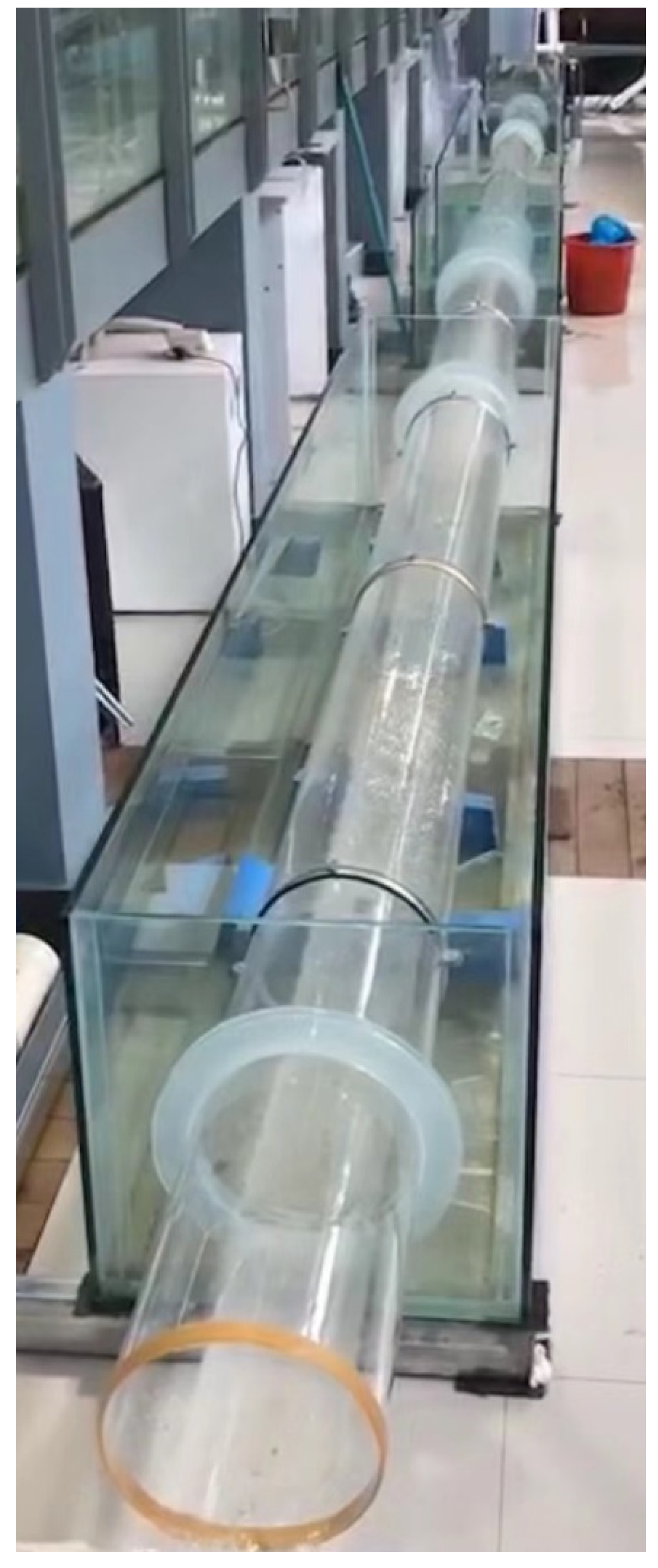
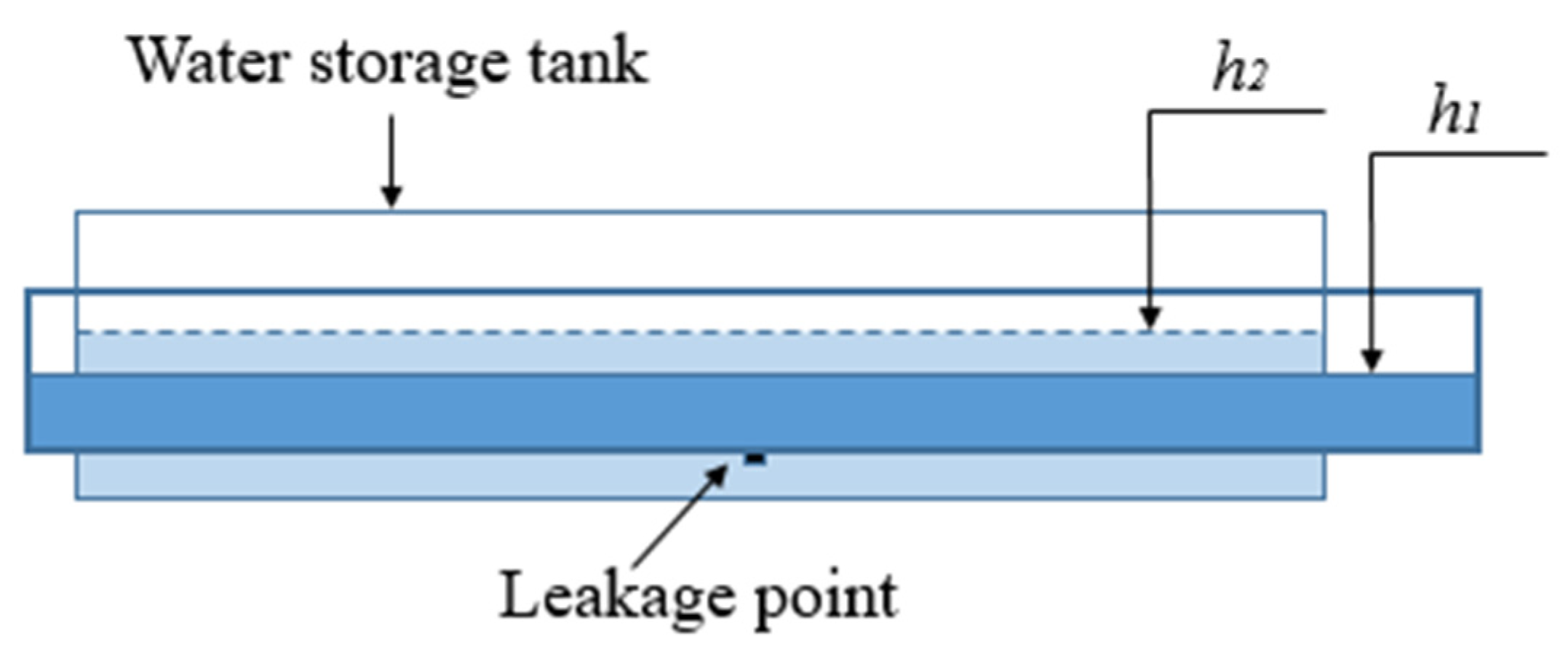
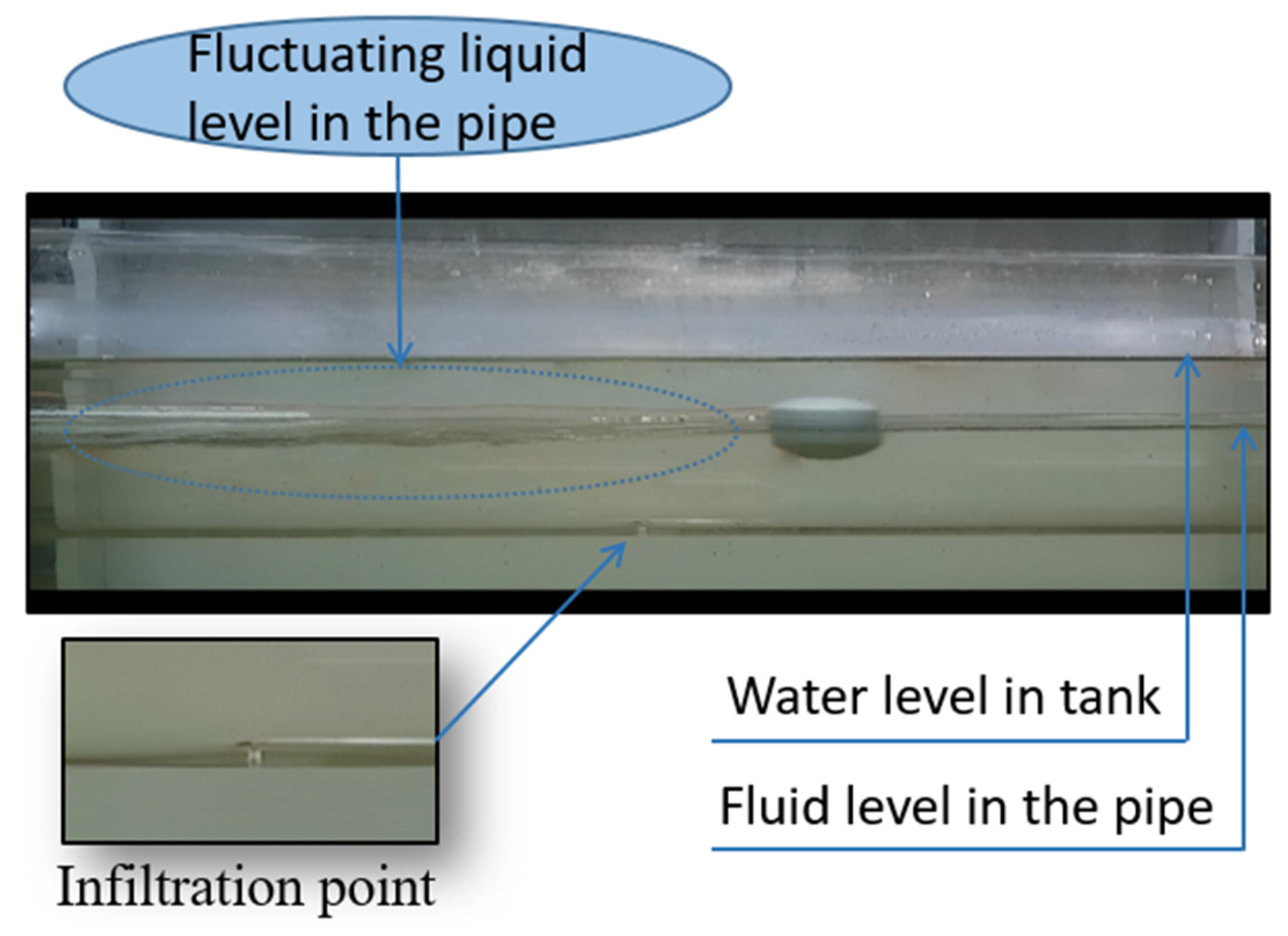

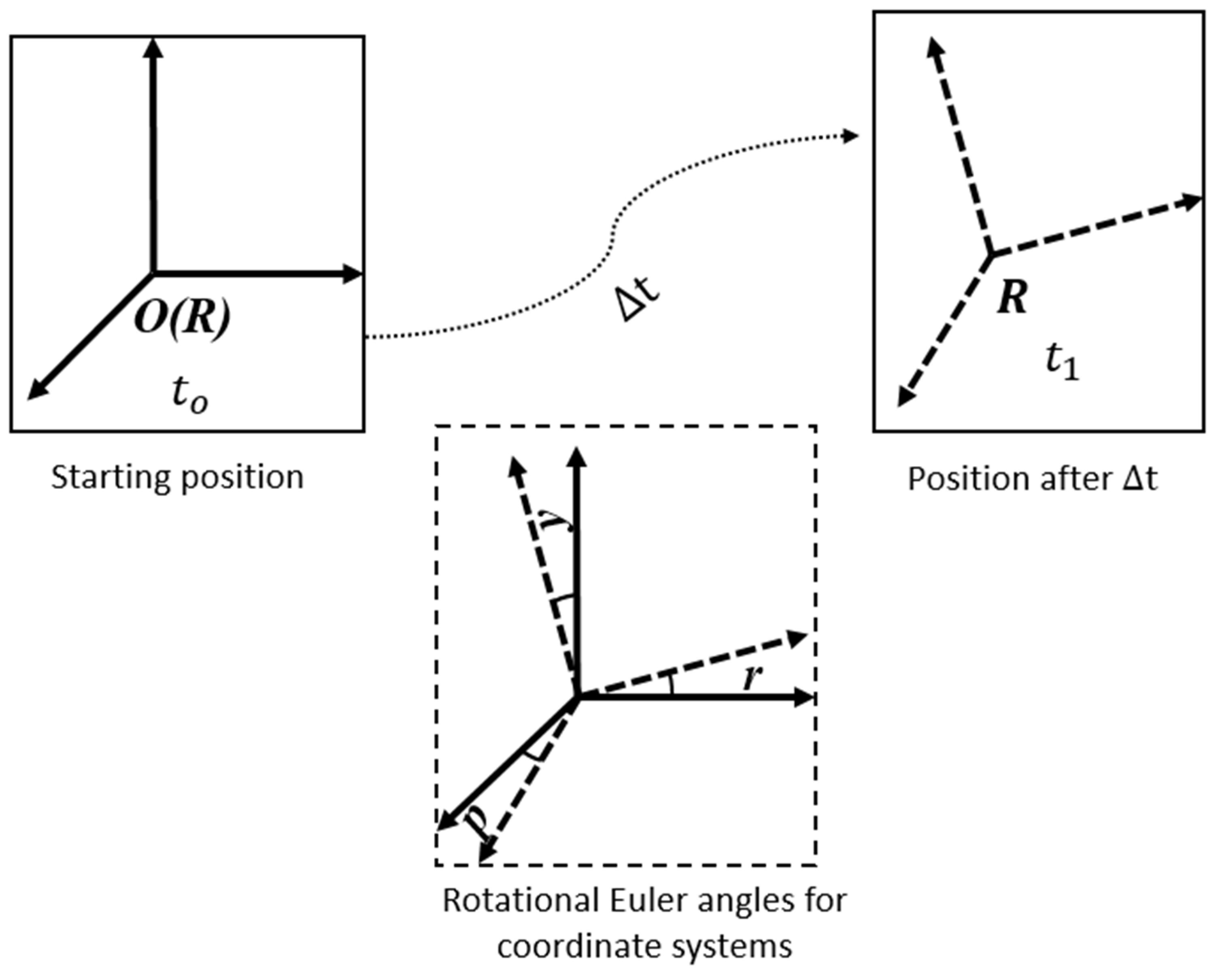


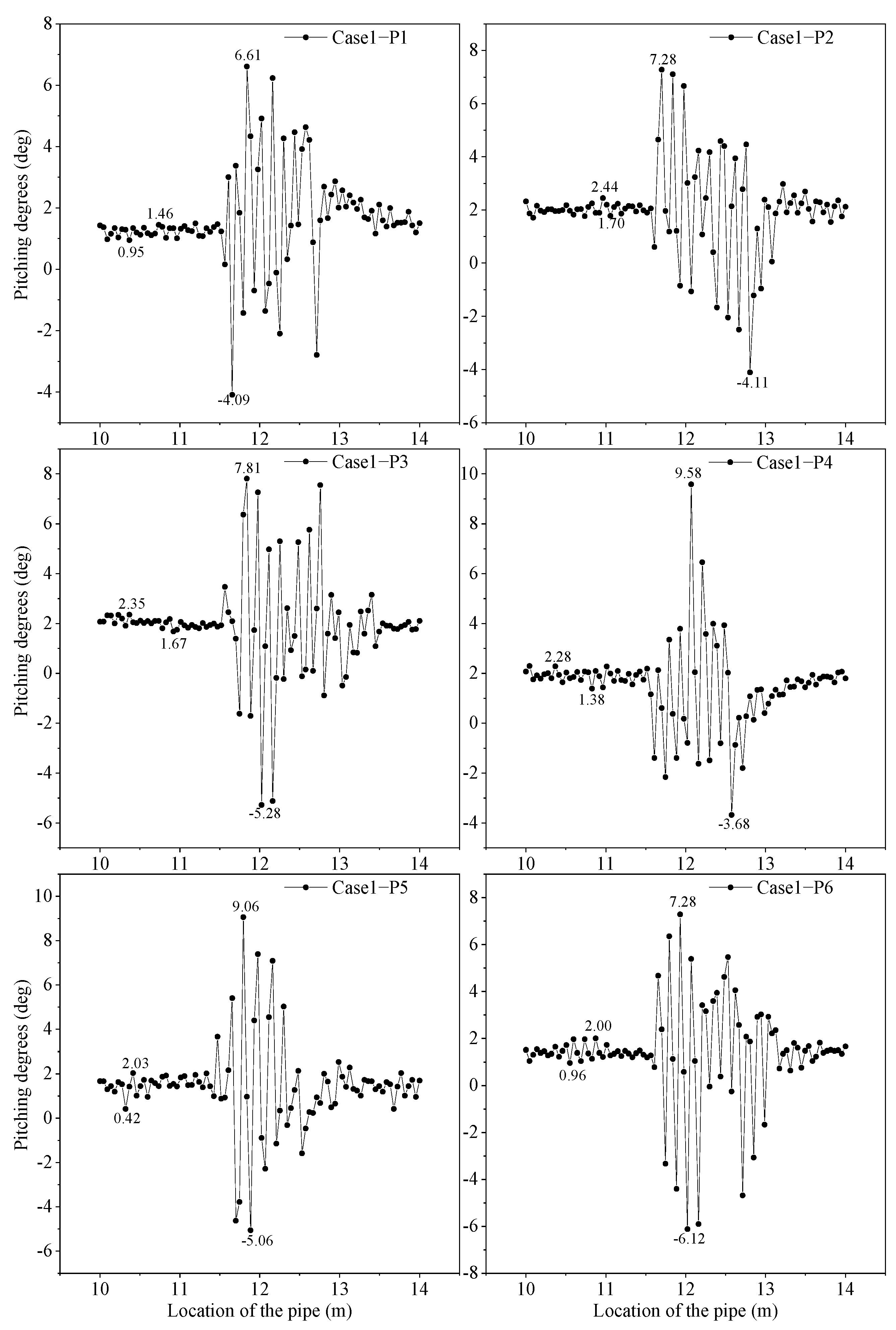
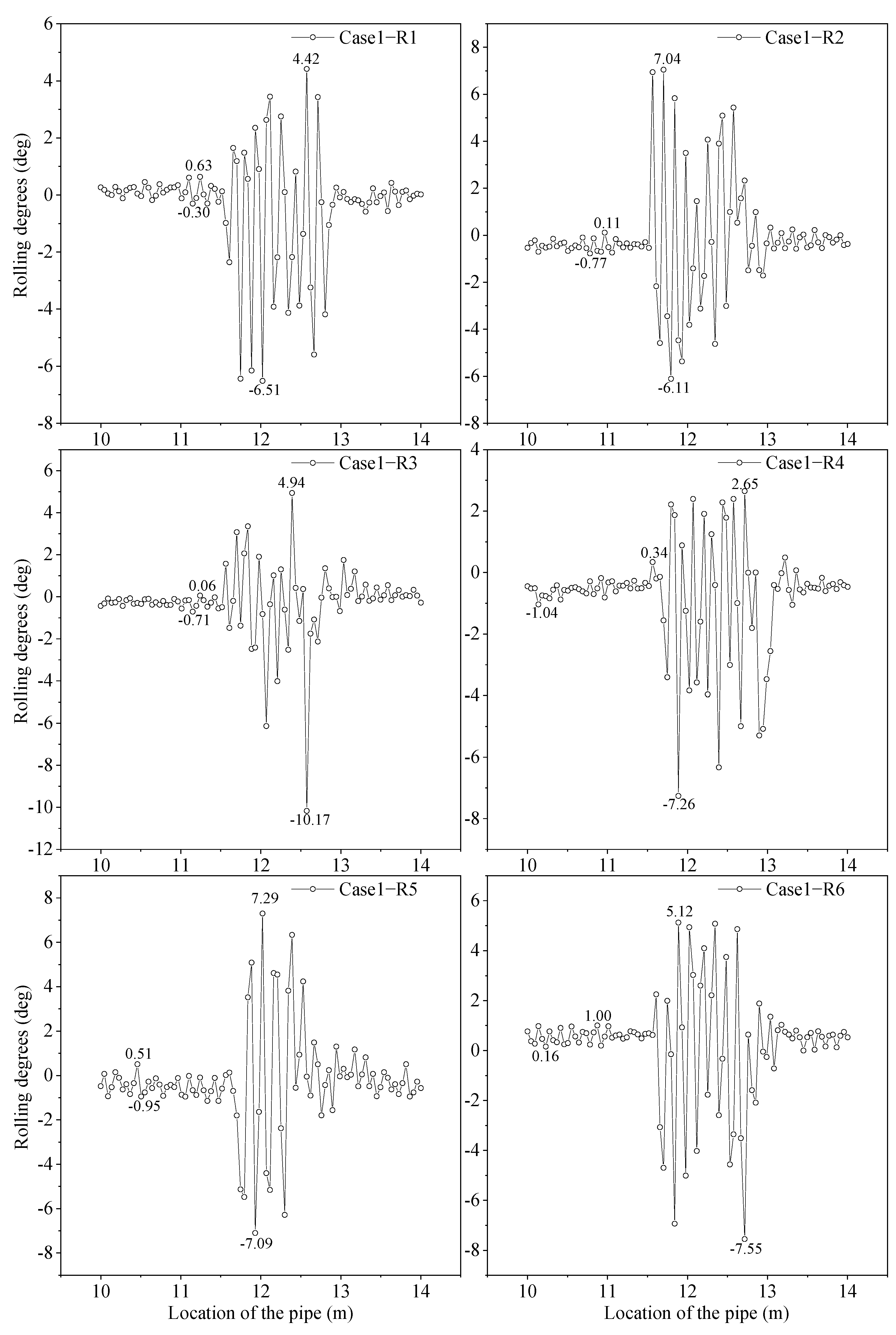



| Q (L/s) | ∆h (cm) | (L/s) | K (%) | |
|---|---|---|---|---|
| Case 1 | 10 | 5 | 0.46 | 4.6 |
| Case 2 | 10 | 3 | 0.29 | 2.9 |
| C1-P1 | C1-P2 | C1-P3 | C1-P4 | C1-P5 | C1-P6 | Average | |
|---|---|---|---|---|---|---|---|
| RC1-P | 20.99 | 15.40 | 19.25 | 14.73 | 23.15 | 12.88 | 17.73 |
| C1-R1 | C1-R2 | C1-R3 | C1-R4 | C1-R5 | C1-R6 | Average | |
|---|---|---|---|---|---|---|---|
| RC1-R | 11.76 | 14.94 | 19.62 | 7.18 | 9.85 | 17.12 | 13.41 |
| C2-P1 | C2-P2 | C2-P3 | C2-P4 | C2-P5 | C2-P6 | Average | |
|---|---|---|---|---|---|---|---|
| RC2-P | 9.41 | 8.19 | 8.91 | 6.60 | 8.27 | 9.67 | 8.51 |
| C2-R1 | C2-R2 | C2-R3 | C2-R4 | C2-R5 | C2-R6 | Average | |
|---|---|---|---|---|---|---|---|
| RC2-R | 12.09 | 10.35 | 4.44 | 6.75 | 10.26 | 8.26 | 8.69 |
Disclaimer/Publisher’s Note: The statements, opinions and data contained in all publications are solely those of the individual author(s) and contributor(s) and not of MDPI and/or the editor(s). MDPI and/or the editor(s) disclaim responsibility for any injury to people or property resulting from any ideas, methods, instructions or products referred to in the content. |
© 2023 by the authors. Licensee MDPI, Basel, Switzerland. This article is an open access article distributed under the terms and conditions of the Creative Commons Attribution (CC BY) license (https://creativecommons.org/licenses/by/4.0/).
Share and Cite
Xiao, Y.; Meng, J.; Yan, H.; Wang, J.; Xin, K.; Tao, T. Research on the Application of MEMS Gyroscope in Inspecting the Breakage of Urban Sewerage Pipelines. Water 2023, 15, 2426. https://doi.org/10.3390/w15132426
Xiao Y, Meng J, Yan H, Wang J, Xin K, Tao T. Research on the Application of MEMS Gyroscope in Inspecting the Breakage of Urban Sewerage Pipelines. Water. 2023; 15(13):2426. https://doi.org/10.3390/w15132426
Chicago/Turabian StyleXiao, Yunlong, Jinheng Meng, Hexiang Yan, Jiaying Wang, Kunlun Xin, and Tao Tao. 2023. "Research on the Application of MEMS Gyroscope in Inspecting the Breakage of Urban Sewerage Pipelines" Water 15, no. 13: 2426. https://doi.org/10.3390/w15132426
APA StyleXiao, Y., Meng, J., Yan, H., Wang, J., Xin, K., & Tao, T. (2023). Research on the Application of MEMS Gyroscope in Inspecting the Breakage of Urban Sewerage Pipelines. Water, 15(13), 2426. https://doi.org/10.3390/w15132426





